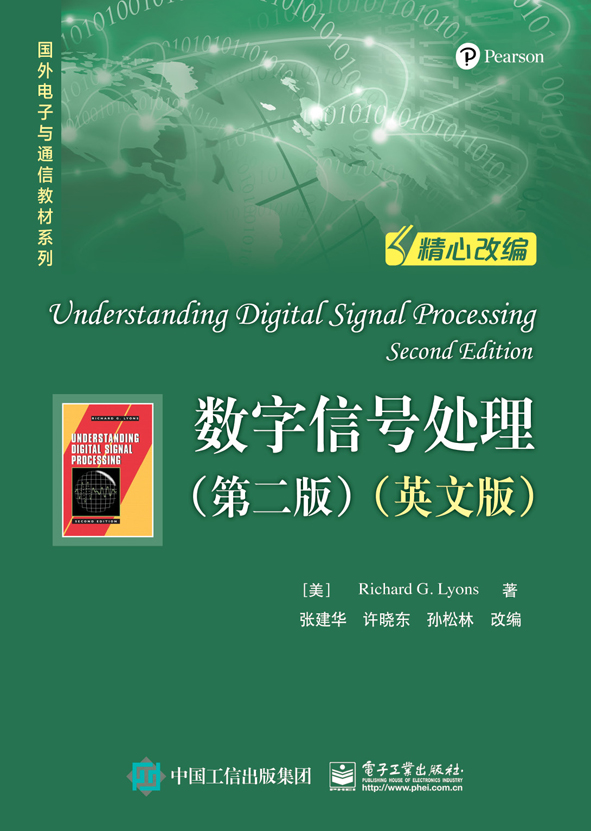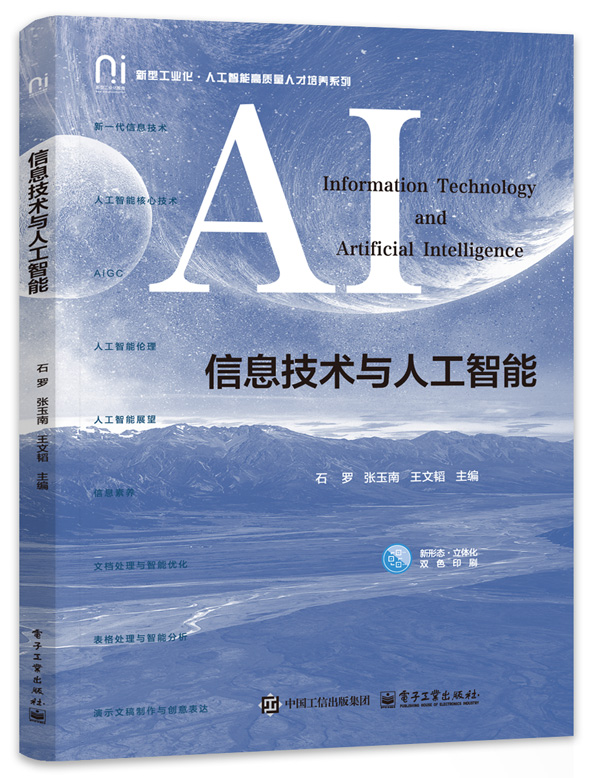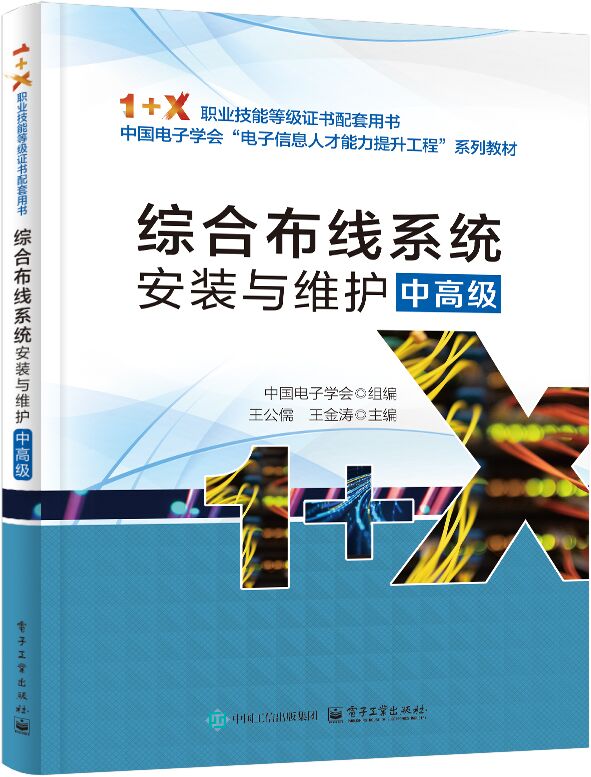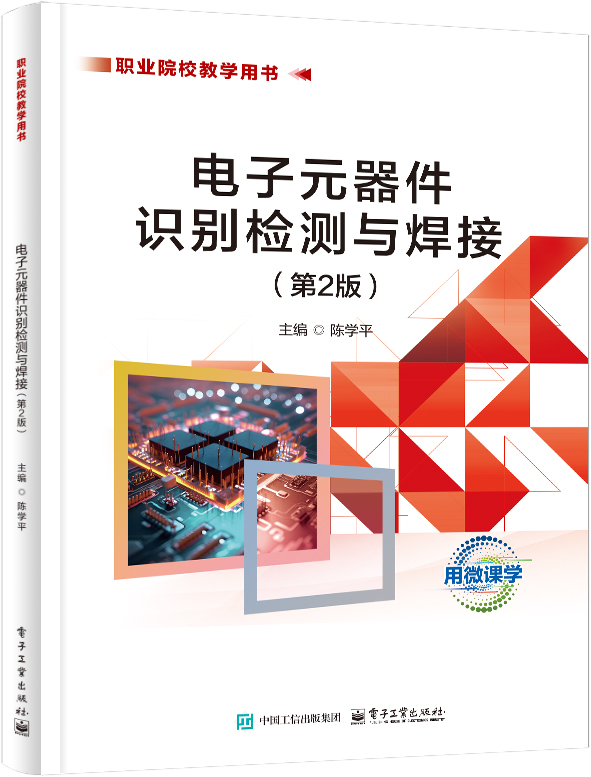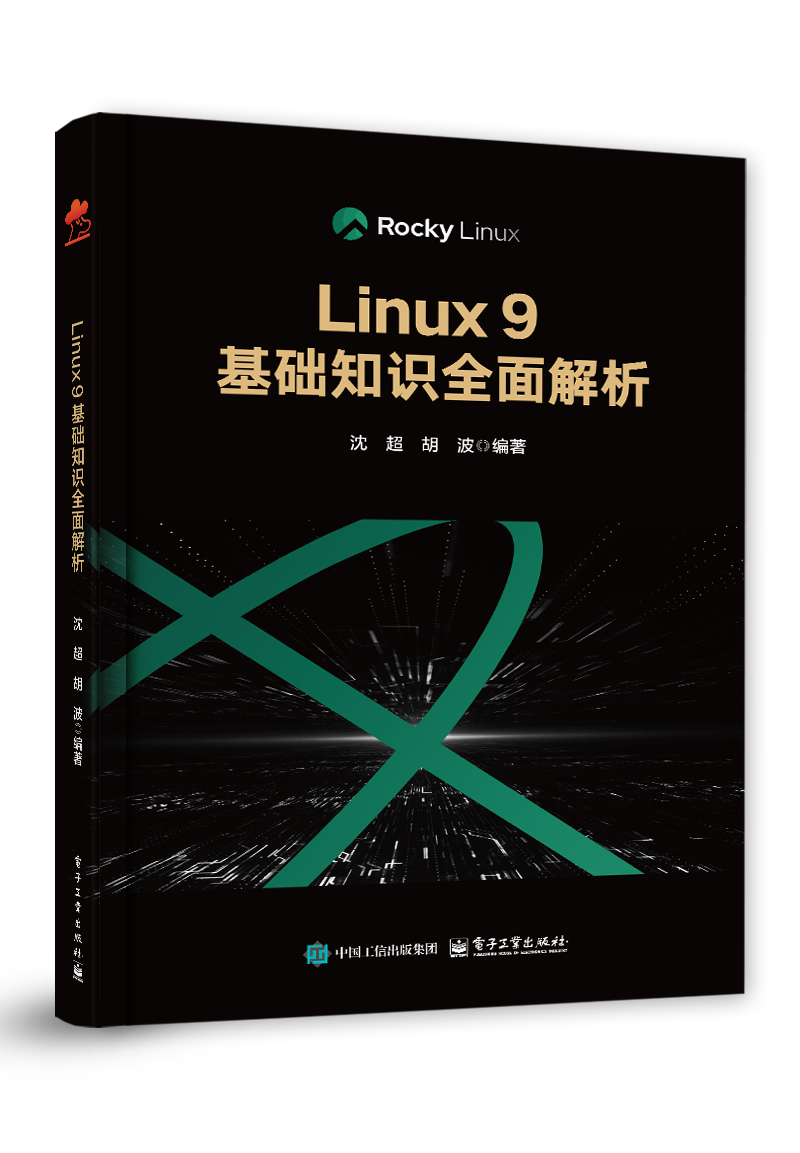数字信号处理(第二版)(英文版)
丛 书 名:
国外电子与通信教材系列
作 译 者:张建华等
出 版 日 期:2017-02-01
书 代 号:G0309200
I S B N:9787121309205
图书简介:
本书在Richard G. Lyons所著Understanding Digital Signal Processing, Second Edition的基础上进行了改编,针对通信类学校本科教学大纲,删除了教学中一般不涉及的内容,调整了章节顺序,并增加了z反变换、滤波器结构、线性相位FIR滤波器和其结构、模拟滤波器简介的内容,使教内容材更加完整。全书在概述了离散序列和系统的定义和实例之后,详细讨论了离散系统的特性、信号的离散化和离散卷积、z变换、离散时间傅里叶变换和离散傅里叶变换、快速傅里叶变换、数字滤波器结构、以及有限和无限脉冲响应数字滤波器的设计等基本概念和基本理论。书中涉及的数学知识以简明形式给出,深入浅出,易于理解。本书每章都增加了例题、习题和MATLAB例题,以便加强对每章内容的理解和掌握。
-
配 套 资 源
-
图 书 内 容
内容简介
本书在Richard G. Lyons所著Understanding Digital Signal Processing, Second Edition的基础上进行了改编,针对通信类学校本科教学大纲,删除了教学中一般不涉及的内容,调整了章节顺序,并增加了z反变换、滤波器结构、线性相位FIR滤波器和其结构、模拟滤波器简介的内容,使教内容材更加完整。全书在概述了离散序列和系统的定义和实例之后,详细讨论了离散系统的特性、信号的离散化和离散卷积、z变换、离散时间傅里叶变换和离散傅里叶变换、快速傅里叶变换、数字滤波器结构、以及有限和无限脉冲响应数字滤波器的设计等基本概念和基本理论。书中涉及的数学知识以简明形式给出,深入浅出,易于理解。本书每章都增加了例题、习题和MATLAB例题,以便加强对每章内容的理解和掌握。图书详情
ISBN:9787121309205开 本:16开页 数:304字 数:553.0本书目录
Chapter 1 Discrete Sequences and Systems 1 1.1 Discrete Sequences and Their Notation 1 1.1.1 Discrete-time Signals 2 1.1.2 Frequently Used Discrete Sequences 7 1.2 Signal Amplitude, Magnitude, Power 9 1.3 Signal Processing Operational Symbols 10 1.4 Introduction to Discrete Linear Time-Invariant Systems 12 1.5 Discrete Linear Systems 12 1.5.1 Example of a Linear System 12 1.5.2 Example of a Nonlinear System 14 1.6 Time-Invariant Systems 16 1.6.1 Example of a Time-Invariant System 16 1.7 The Commutative Property of Linear Time-Invariant Systems 17 1.8 The Causality Property of Linear Time-Invariant Systems 18 1.9 The Stability Property of Linear Time-Invariant Systems 18 1.10 Analyzing Linear Time-Invariant Systems 19 1.11 Problems 20 1.12 MATLAB Applications 22 1.12.1 Applications 22 1.12.2 Examples 23 1.12.3 Exercises 24 Chapter 2 Periodic Sampling 25 2.1 Aliasing: Signal Ambiguity in the Frequency Domain 25 2.2 Sampling Low-Pass Signals 29 2.3 A Generic Description of Discrete Convolution 32 2.3.1 Discrete Convolution in the Time Domain 33 2.3.2 The Convolution Theorem 36 2.3.3 Applying the Convolution Theorem 39 2.4 Problems 42 2.5 Matlab Applications 43 2.5.1 Applications 43 2.5.2 Examples 44 2.5.3 Exercises 46 Chapter 3 Z-Transform 47 3.1 The z-Transform 47 3.1.1 Poles and Zeros on the z-Plane and Stability 49 3.1.2 The ROC of z-Transform 50 3.1.3 The Properties of z-Transform 53 3.2 The Inverse z-Transform 55 3.2.1 General Expression of Inverse z-Transform 55 3.2.2 Inverse z-Transform by Partial-Fraction Expansion 58 3.3 Problems 61 3.4 MATLAB Applications 63 3.4.1 Applications 63 3.4.2 Examples 64 3.4.3 Exercises 67 Chapter 4 The Discrete Fourier Transform 68 4.1 Interpreting the DFT 69 4.2 Understanding the DFT Equation 71 4.2.1 DFT Example 1 74 4.3 DFT Properties 81 4.3.1 DFT Symmetry 81 4.3.2 DFT Linearity 83 4.3.3 DFT Magnitudes 83 4.3.4 DFT Frequency Axis 84 4.3.5 DFT Shifting Theorem 85 4.4 Inverse DFT 87 4.5 DFT Leakage 88 4.6 Windows 94 4.7 DFT Resolution, Zero Padding, and Frequency-Domain Sampling 101 4.8 Frequency Response 104 4.9 Problems 106 4.10 Matlab Applications 107 4.10.1 Applications 107 4.10.2 Examples 108 4.10.3 Exercises 111 Chapter 5 The Fast Fourier Transform 112 5.1 Relationship of the FFT to the DFT 112 5.2 FFT Alogrithm 113 5.3 Derivation of the Radix-2 FFT Algorithm 114 5.4 FFT Input/Output Data Index Bit Reversal 120 5.5 Radix-2 FFT Butterfly Structures 121 5.6 Efficiently Performing the FFT of Real Sequences 127 5.6.1 Performing Two N-Point Real FFTs 127 5.6.2 Performing a 2N-Point Real FFT 133 5.7 Discrete Convolution using FFT 137 5.7.1 Overlap-added 138 5.7.2 Overlap-saved 138 5.8 IFFT Algorithm 140 5.9 Problems 143 5.10 Matlab Applications 144 5.10.1 Applications 144 5.10.2 Examples 144 5.10.3 Exercises 146 Chapter 6 Filter Structure 147 6.1 Block Structure 147 6.2 Mason and Transpose Theorem 149 6.2.1 Mason誷 Rule 149 6.2.2 Transpose Theorem 150 6.3 Example of Filter Structures 151 6.3.1 IIR Filter Structure 151 6.3.2 FIR Direct Structure 158 6.3.3 FIR Cascade Structure 158 6.4 Problems 159 6.5 Matlab Applications 162 6.5.1 Applications 162 6.5.2 Examples 163 6.5.3 Exercises 167 Chapter 7 Finite Impulse Response Filters 168 7.1 An Introduction to Finite Impulse Response (FIR) Filters 169 7.2 Properties of FIR Filters 172 7.2.1 Convolution in FIR Filters 172 7.2.2 Linear phase FIR Filter 181 7.2.3 Linear Phase FIR Filter Structure 188 7.2.4 FIR Filter Poles and Zeros 194 7.3 Low-Pass FIR Filter Design 196 7.3.1 Window Design Method 197 7.3.2 Windows Used in FIR Filter Design 204 7.3.3 Examples to Design Linear Phase Low-Pass FIR Filter 210 7.4 Examples to Design Other Types Linear Phase FIR Filter 215 7.5 Problems 220 7.6 Matlab Exercises 223 7.6.1 Applications 223 7.6.2 Examples 223 7.6.3 Exercises 224 Chapter 8 Infinite Impulse Response Filters 226 8.1 An Introduction to Infinite Impulse Response Filters 227 8.2 The Laplace Transform 229 8.2.1 Poles and Zeros on the s-Plane and Stability 234 8.3 Analog Low-Pass Filters 239 8.3.1 Introduction 240 8.3.2 Approximation of analog filter characteristics 240 8.3.3 Butterworth Approximation 242 8.3.4 Chebyshev Approximation 247 8.4 Impulse Invariance IIR Filter Design Method 253 8.4.1 Impulse Invariance Design Method 1 Example 258 8.4.2 Impulse Invariance Design Method 2 Example 260 8.5 Bilinear Transform IIR Filter Design Method 266 8.5.1 Bilinear Transform Design Example 271 8.6 Low-Pass IIR Filter Design 274 8.6.1 Example of Low-Pass IIR Digital Filter Design 274 8.6.2 a Brief Comparison of IIR and FIR Filters 277 8.7 Other Types IIR Filter Design 278 8.8 Problems 284 8.9 Matlab Exercises 286 8.9.1 Functions of IIR Design 286 8.9.2 Examples 287 8.9.3 Exercises 288展开前 言
本书特色 ◆ 强调结合工程应用的DSP例子并给出解决思路 ◆ 丰富了z变换、DRFT变换等DSP重要内容 ◆ 增加了习题和DSP编程的内容 ◆ 通俗、易于理解的语言风格和内容 ◆ 丰富、直观的大量DSP例题和方案 ◆ 给出了滤波器结构的实现手段 改 编 者 序 本书是在Understanding Digital Signal Processing, Second Edition的基础上改编的英文版教材,适合数字信号处理(DSP)基础相关课程40学时到64学时的英语或双语教学使用。 本书的作者Richard G. Lyons毕业于美国加州阿克隆大学。他曾是美国国家安全局和TRW(天合)汽车集团公司众多DSP系统的首席硬件工程师,负责系统设计、开发、测试和安装。他曾在加利福尼亚大学圣塔克鲁兹分校任教,并发表过很多有关DSP的文章。作为IEEE Signal Processing Magazine的副主编,由他开设了DSP Tips & Tricks专栏并且负责编辑。正是由于其在DSP领域的长期工作经验和教学经历,编写的此书受到了很多数字信号处理初学者和使用者的高度评价,认为此书将“理论与实践完美地结合起来”。由于数字信号处理是一门应用性很强的课程,需要大量的经验积累,而此书通过具有启发性的解释和精心挑选的例子,采用读者可以理解的数学表示方法,对数字信号处理技术进行了解释,帮助读者从整体上掌握DSP,并逐步掌握较高层次的DSP概念和应用。这也是改编者选择此书的初衷,希望读者不仅了解DSP的概念,而且通过例子的学习,在今后的工作和科研工作中,会用DSP的知识解决实际问题。 Understanding Digital Signal Processing, Second Edition的内容体系与国内高校数字信号处理基础相关课程的教学内容有较高的统一性,但是,通过亲自实践以及进一步考察国内高校相关学科开展双语教学的情况,也发现本书与国内高校的教学内容和课程安排存在一定不匹配之处。自国内高校教育改革以来,大部分院校都开设了DSP课程,而且内容也基本形成了一致,而本书的内容相对国内的授课学时和知识体系显得内容过于庞大。例如,关于信号量化的内容在国内高等院校的授课中通常是介绍性的,而原书用了整章的篇幅(第8章)来详细介绍;关于离散希尔伯特变换、信号平均和数字信号格式等内容,通常在国内数字信号处理基础课程教学中也很少涉及,或者属于只要求学生了解的内容。但对于数字信号处理使用的常用方法,MATLAB在国内一般都会作为数字信号处理实验的内容来介绍,但本书却没有涉及。 为了使教材内容更合理,范围宽窄适度,内容深浅适中,进而满足国内和国际高等教育相关专业数字信号处理课程的教学要求,适应国内教育教学特色,并便于学生在有限学时下把握重点,深入理解,而且学以致用,我们以精简内容和突出重点为目标对这本书进行了改编。删除了教学中一般不涉及的内容,调整了章节顺序,并增加了z反变换、滤波器结构、线性相位FIR滤波器及其结构、模拟滤波器简介等内容,使教材内容更加完整。全书在概述了离散序列和系统的定义及实例之后,详细讨论了离散系统的特性、信号的离散化和离散卷积、z变换、离散时间傅里叶变换和离散傅里叶变换、快速傅里叶变换、数字滤波器结构及有限和无限脉冲响应数字滤波器的设计等基本概念和基本理论。书中涉及的数学知识以简明形式给出,深入浅出,易于理解。本书每章都增加了例题、习题和MATLAB例题,便于加强对每章内容的理解和掌握。本书可作为理工类大专院校的电子、计算机、通信等专业的本科生教材,对于DSP领域的工程技术人员和专业技术人员也有很好的参考价值。 本书第1章至第3章由许晓东教师负责改编,第4章至第6章由孙松林老师负责改编,第7章和第8章由张建华老师负责改编,全书由张建华老师负责统校。在本书的改编过程中,一方面结合了改编者们在北京邮电大学国际学院开展数字信号处理双语授课的实践经验(教学用PPT等教辅资源可联系malan@phei.com.cn申请),另一方面,北京邮电大学门爱东教授、苏菲教授和已退休的周利清教授都给予我们许多帮助和指导,在此表示衷心感谢!最后感谢热心的国际学院已毕业的学生王禹宁和闫 等对本书的关注,感谢许多无法一一提及的支持此书的老师和同学! Preface This book is an expansion of the original Understanding Digital Signal Processing textbook published in 1997 and, like the first edition, its goal is to help beginners understand this relatively new technology of digital signal processing (DSP). Additions to this second edition include: ● Expansion and clarification of selected spectrum analysis and digital filtering topics covered in the first edition making that material more valuable to the DSP beginner. ● Discussions of Frequency Sampling, Interpolated FIR, and CIC filters; giving these important filters greater exposure than they‘re received in past DSP textbooks. ● Revision of the terminology making it more consistent with the modern day language of DSP. It誷 traditional at this point in the preface of a DSP textbook for the author to tell readers why they should learn DSP. I don't need to tell you how important DSP is in our modern engineering world, you already know that. I'll just say that the future of electronics is DSP, and with this book you will not be left behind. LEARNING DIGITAL SIGNAL PROCESSING Learning the fundamentals, and how to speak the language, of digital signal processing does not require profound analytical skills or an extensive background in mathematics. All you need is a little experience with elementary algebra, knowledge of what a sinewave is, this book, and enthusiasm. This may sound hard to believe, particularly if you're just flipped through the pages of this book and seen figures and equations that look rather complicated. The content here, you say, looks suspiciously like the material in technical journals and textbooks that, in the past, have successfully resisted your attempts to understand. Well, this is not just another book on digital signal processing. This book's goal is to gently provide explanation followed by illustration, not so that you may understand the material, but that you must understand the material. ① Remember the first time you saw two people playing chess? The game probably appeared to be mysterious and confusing. As you now know, no individual chess move is complicated. Given a little patience, the various chess moves are easy to learn. The games complexity comes from deciding what combinations of moves to make and when to make them. So it is with understanding digital signal processing. First we learn the fundamental rules and processes, and then practice using them in combination. If learning digital signal processing is so easy, then why does the subject have the reputation of being hard to understand? The answer lies partially in how the material is typically presented in the literature. It's difficult to convey technical information, with its mathematical subtleties, in written form. It's one thing to write equations, but it's another matter altogether to explain what those equations really mean from a practical standpoint, and that's the goal of this book. Too often, written explanation of digital signal processing theory appears in one of two forms: either mathematical miracles occur and the reader is simply given a short and sweet equation without further explanation, or the reader is engulfed in a flood of complex variable equations and phrases such as it is obvious that,?and with judicious application of the homogeneity property.?In their defense, authors usually do provide the needed information, but too often the reader must figuratively grab a pick and shovel, put on a miner's helmet, and try to dig the information out of a mountain of mathematical expressions. (This book presents the results of several fruitful mining expeditions.) How many times have you followed the derivation of an equation, after which the author states they're going to illustrate that equation with an example--which turns out to be just another equation? Although mathematics is necessary to describe digital signal processing, I've tried to avoid overwhelming the reader with math because a recipe for technical writing that's too rich in equations is hard for the beginner to digest. The intent of this book is expressed by a popular quote from E. B. White in the introduction of his Elements of Style (Macmillan Publishing, New York, 1959): "Will (Strunk) felt that the reader was in serious trouble most of the time, a man floundering in a swamp, and that it was the duty of anyone attempting to write English to drain the swamp quickly and get his man up on dry ground, or at least throw him a rope.? I誺e attempted to avoid the traditional instructor-student relationship, but rather to make reading this book like talking to a friend while walking in the park. I誺e used just enough mathematics to develop a fundamental understanding of the theory, and then illustrate that theory with practical examples. THE JOURNEY Learning digital signal processing is not something you accomplish; it's a journey you take. When you gain an understanding of some topic, questions arise that cause you to investigate some other facet of digital signal processing. ① Armed with more knowledge, you're likely to begin exploring further aspects of digital signal processing much like those shown in the following diagram. This book is your tour guide during the first steps of your journey. You don誸 need a computer to learn the material in this book, but it would sure help. DSP simulation software allows the beginner to verify signal processing theory through the time-tested trial and error process. ② In particular software routines that plot signal data, perform the fast Fourier transforms, and analyze digital filters would be very useful. As you go through the material in this book, don't be discouraged if your understanding comes slowly. As the Greek mathematician Menaechmus curtly remarked to Alexander the Great, when asked for a quick explanation of mathematics, "There is no royal road to mathematics.?Menaechmus, was confident in telling Alexander the only way to learn mathematics is through careful study. The same applies to digital signal processing. Also, don't worry if you have to read some of the material twice. While the concepts in this book are not as complicated as quantum physics, as mysterious as the lyrics of the song Louie Louie, or as puzzling as the assembly instructions of a metal shed, they do get a little involved. They deserve your attention and thought. So go slow and read the material twice if you have to; you'll be glad you did. If you show persistence, to quote a phrase from Susan B. Anthony, "Failure is impossible." COMING ATTRACTIONS Chapter 1 begins by establishing the notation used throughout the remainder of the book. In that chapter we introduce the concept of discrete signal sequences, show how they relate to continuous signals, and illustrate how those sequences can be depicted in both the time and frequency domains. In addition, Chapter 1 defines the operational symbols we'll use to build our signal processing system block diagrams. We conclude that chapter with a brief introduction to the idea of linear systems and see why linearity enables us to use a number of powerful mathematical tools in our analysis. Chapter 2 introduces the most frequently misunderstood process in digital signal processing, periodic sampling. Although it's straightforward to grasp the concept of sampling a continuous signal, there are mathematical subtleties in the process that require thoughtful attention. Beginning gradually with simple examples of low-pass sampling, Chapter 2 explains and quantifies the frequency domain ambiguity (aliasing) associated with these important topics. Chapter 3 is one chapter to explain z transform. z transform is one of very useful tools to analyze discrete signals and systems. Thus we will learn how to transform signals or systems to z domain and also how to inverse transform z signals and system to its time domain form. From this chapter, we will master more powerful mathematical tools in later DSP studying. Chapter 4 is devoted to one of the foremost topics in digital signal processing, the discrete Fourier transform (DFT) used for spectrum analysis. Coverage begins with detailed examples illustrating the important properties of the DFT and how to interpret DFT spectral results, progresses to the topic of windows used to reduce DFT leakage, and discusses the processing gain afforded by the DFT. The chapter concludes with a detailed discussion of the various forms of the transform of rectangular functions that the beginner is likely to encounter in the literature. That last topic is included there to clarify and illustrate the DFT of both real and complex sinusoids. Chapter 5 covers the innovation that made the most profound impact on the field of digital signal processing, the fast Fourier transform (FFT). There we show the relationship of the popular radix-2 FFT to the DFT, quantify the powerful processing advantages gained by using the FFT, demonstrate why the FFT functions as it does, and present various FFT implementation structures. Chapter 5 also includes a list of recommendations to help the reader use the FFT in practice. Chapter 6 introduces reader about FIR and IIR filter structures. For structure will affect the efficiency and stability of filter. In Chapter 6, block structure is firstly presented and Mason theorem is used to get its transfer function for the specified structure. FIR and IIR typical structure are also summarized in this chapter. Chapter 7 ushers in the subject of digital filtering. Beginning with a simple low-pass finite impulse response (FIR) filter example, we carefully progress through the analysis of that filter's frequency domain magnitude and phase response. Next we learn how window functions affect, and can be used to design, FIR filters. The methods for converting low-pass FIR filter designs to bandpass and high pass digital filters are presented. Chapter 8 is devoted to a second class of digital filters, infinite impulse response (IIR) filters. In discussing several methods for the design of IIR filters, Chapter 8 starts by gently guiding the reader from the origin, through the properties, and on to the utility of the Laplace transform in preparation for learning the z-transform. We’ll see how IIR filters are designed and implemented, and why their performance is so different from FIR filters. To indicate under what conditions these filters should be used, that chapter concludes with a qualitative comparison of the key properties of FIR and IIR filters. 改编者简介 张建华 女,博士,北京邮电大学岗位特聘教授。2002年选送到德国汉堡-哈堡科技大学深造半年,从2005年开始从事数字信号处理课程的双语教学工作,2008年受国家留学基金委支持前往韩国访问学习半年。先后主持和参加了10余个国家自然科学基金、国家863计划重点项目、国家科技重大专项和企业合作项目。截至2010年4月,在国际会议和期刊已发表90余篇文章,其中SCI检索9篇(发表在JCN杂志的文章获得2008年唯一最佳论文奖),目前担任IEEE多种杂志和期刊的审稿人;申请专利20余项,授权4项;2005年入选北京市科技新星人才培养计划。2006年获中国通信学会科学技术一等奖1次,2008年获国家技术发明奖二等奖1次,2009年获中国通信标准化协会科学技术二等奖1次。鉴于此,2010年4月被北京邮电大学评为“岗位特聘教授”。 许晓东 男,博士,北京邮电大学副教授。研究方向为下一代移动通信系统及通信系统中的信号处理技术,于2007年开始从事数字信号处理课程的双语教学工作。目前已出版包括普通高等教育“十一五”国家级规划教材在内的教材及专著3部。已承担及参与自然科学基金重大项目子课题、863高技术项目、中瑞国际合作项目、北京市科技计划项目、企业合作项目10余项。在国内外期刊和国际会议发表学术论文40余篇,其中6篇为SCI检索论文,目前担任IEEE多种杂志及国内外学术期刊的审稿人。已申请移动通信及信号处理相关发明专利12项,其中1项已授权,3项专利相关的标准提案被3GPP和3GPP2等标准化组织接纳。 孙松林 男,博士,北京邮电大学副教授。研究方向为无线多媒体通信与信号处理、嵌入式系统。先后主持和参加了10余个国家自然科学基金、国家科技重大专项、省部级预研和企业合作项目。在国内外期刊和国际会议发表学术论文20余篇,合作出版教材和专著3部。是IEEE Networking和《电子学报》等多种期刊杂志的审稿人。展开作者简介
本书暂无作者简介 -
样 章 试 读
-
图 书 评 价 我要评论
